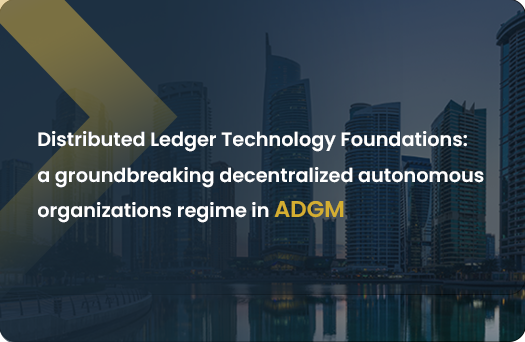Further to Abu Dhabi Global Market’s (ADGM) consultation paper on the creation of specialised foundations for decentralised autonomous organisations (DAOs) in April,2023, on 2 November 2023, the ADGM has officially released the groundbreaking Distributed Ledger Technology Foundations Regulations 2023 (DLT Regulations), marking a significant milestone in the evolution of digital assets regulatory frameworks across the region and at an international level.
The Regulations, the first in the world, will provide a legal framework for the establishment and operation of distributed ledger technology (DLT) foundations.
A DLT foundation is a legal entity that can hold and manage digital assets for a specified purpose, such as supporting a DLT network or protocol.
How to Register a DLT Foundation?
To register a DLT foundation, the founder is required to submit a charter and accompanying documents to the DLT foundation registrar. Additionally, a specified fee must be paid as part of the registration process. The charter should outline the foundation’s objectives, proposed activities, governance structure, identified beneficiaries, and delineate the rights and responsibilities of tokenholders. Tokenholders, defined as individuals holding or managing tokens issued by the DLT foundation, possess specific voting and information-related privileges.
A DLT foundation is required to maintain a minimum initial asset value of US$ 50,000, with the option to receive further endowments from the founder or other external sources. It’s important to note that the assets of the DLT foundation remain separate from those belonging to the founder, councillors, guardian, and beneficiaries. Importantly, these assets are not governed by foreign laws that could impact their ownership or transfer.
What are the Governance requirements of a DLT Foundation?
The governance of a DLT foundation consists of a foundation council, a guardian, and the tokenholders
The foundation council holds the responsibility of overseeing the management of assets and operations of the DLT foundation, aligning with both the charter and the DLT Regulations. Comprising a minimum of two and a maximum of 16 councillors, each subject to specific qualifications and duties, the council has extended authority in managing the foundation’s assets. It plays a main role in executing the foundation’s objectives and ensuring compliance with its charter and relevant obligations by various organizational bodies.
The foundation council possesses veto rights over decisions made by other governance bodies within the foundation. The guardian is appointed by the founder or the council, and has the role of ensuring that the council acts in accordance with the objects of the DLT foundation. The guardian also has certain powers and duties and may be removed or replaced by the council or the tokenholders.
The tokenholders can either approve or reject certain matters that would have an impact on the DLT foundation, including but not limited to, changes to the charter, migration, by passing qualified or ordinary resolutions.
What are the Reporting obligations of a DLT Foundation?
A DLT foundation is mandated to maintain accounting records and prepare annual accounts, which are subject to independent audit by a Registered Auditor. The accounts must be published on the DLT foundation’s website and filed with the Registrar within six months of the end of the financial year. The Registrar holds the authority to review, amend, or mandate corrections to the accounts and can impose fines for non-compliance. Under specific conditions and approvals, a DLT foundation has the option to migrate to or from the ADGM. Additionally, the dissolution of a DLT foundation can occur through court proceedings, Registrar intervention, or by the decision of tokenholders under certain circumstances. If a DLT foundation is removed from the register, it loses its legal entity status, and its assets may be forfeited to the ADGM. Nevertheless, within six years after removal, a DLT foundation can be reinstated on the register if the court or the Registrar deems it just and equitable to do so
As commented by His Excellency Ahmed Jasim Al Zaabi, Chairman of ADGM on the launch and the enactment of the framework as “Abu Dhabi is rapidly emerging as the destination of choice for global players at the forefront of digital asset development. The introduction of the DLT Foundations Regime marks a revolutionary step forward, reinforcing ADGM’s commitment to a proactive approach rooted in extensive cross-industry dialogue and collaboration with various stakeholders. The new regime serves as a driving force for positive change in the digital assets sector. By transforming the blockchain and Web3 landscape, we are moving towards a future characterized by setting global benchmarks with enhanced transparency and efficiency.”, the rapid evolution of Digital Ledger Technology (DLT) in recent years has positioned it as a central component of the global digital assets sector. As a prominent International Financial Center (IFC), the ADGM continues its dedication to advocating technological innovation and providing support for initiatives within the cryptocurrency realm.
ADGM’s commitment to technological innovation and its proactive approach in crafting the DLT Foundations Regime solidifies its position as a leading International Financial Center. The launch of this framework propels ADGM into a future defined by global benchmarks and enhanced transparency, marking a revolutionary step forward in the digital assets sector.
For further inquiries or discussions on DLT foundations, feel free to reach out to us – MS
Disclaimer:
Registered in Abu Dhabi Global Market (Registered No. 000007218),
We are not an ADGM Registered Corporate Service Provider.
